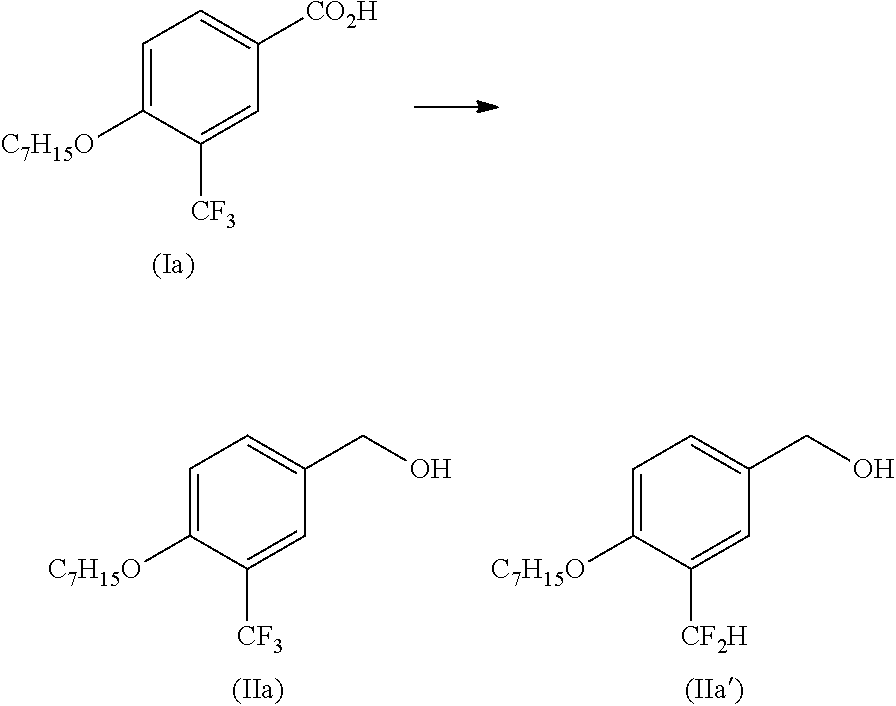4-alkoxy-3-(trifluoromethyl)benzyl alcohol production method
a production method and technology of trifluoromethylbenzyl alcohol, applied in the direction of organic chemistry, chemistry apparatus and processes, group 5/15 element organic compounds, etc., can solve the problems of low and achieve the effect of high conversion ratio and strict suppression of production of byproducts
- Summary
- Abstract
- Description
- Claims
- Application Information
AI Technical Summary
Benefits of technology
Problems solved by technology
Method used
Image
Examples
example 1
[0067]Under a nitrogen atmosphere, to a solution of compound (Ia) (30.0 g, 98.6 mmol) in tetrahydrofuran (THF) (240 mL) was added dropwise a solution of 25% diisobutylaluminum hydride (DIBAL) in toluene (332 mL, 493 mmol), and the mixture was heated to 50° C. and stirred for 2 hr. After cooling to room temperature, methanol (15.80 g, 493 mmol) was added dropwise. The obtained solution was added dropwise to 2N hydrochloric acid (296 mL, 592 mmol), and the mixture was stirred at 50° C. to 60° C. for 30 min and analyzed. As a result, the conversion ratio to the object compound (IIa) was 98.4%. On the other hand, a byproduct such as 3-difluoromethyl-4-heptyloxybenzyl alcohol (hereinafter to be referred to as compound (IIa′)) was not detected.
example 2
Synthesis of 4-heptyloxy-3-trifluoromethylbenzyl chloride (Step A)
[0084]To a solution of compound (IIa) (26.8 g) in methylene chloride (107 mL) was added several drops of N,N-dimethylformamide, and thionyl chloride (8.09 mL) was added dropwise at 0° C. The mixture was stirred at the same temperature for 2 hr, and water (50 mL) was added to the reaction mixture. The organic layer was extracted by partitioning, washed with water (50 mL) and saturated aqueous sodium hydrogen carbonate (70 mL), and dried over anhydrous magnesium sulfate, and the solvent was evaporated under reduced pressure to give 4-heptyloxy-3-trifluoromethylbenzyl chloride (28.3 g) as white crystals.
[0085]1H-NMR (CDCl3) δ (ppm): 0.89 (3H, t, J=6.5 Hz), 1.26-1.54 (8H, m), 1.77-1.86 (2H, m), 4.04 (2H, t, J=6.4 Hz), 4.56 (2H, s), 6.96 (1H, d, J=8.6 Hz), 7.49 (1H, dd, J=2.0 Hz, 8.5 Hz), 7.58 (1H, d, J=1.9 Hz)
example 3
Synthesis of dimethyl (4-heptyloxy-3-trifluoromethylbenzyl)phosphonate (Step B)
[0086]To a solution of 4-heptyloxy-3-trifluoromethylbenzyl chloride (6.00 g, 19.4 mmol) in N,N-dimethylformamide (36 mL) were added dimethyl phosphite (2.57 g, 23.3 mmol), cesium carbonate (7.60 g, 23.3 mmol) and tetrabutylammonium iodide (7.54 g, 20.4 mmol), and the mixture was stirred at 25° C. for 1 day. Toluene (36 mL) and water (18 mL) were added for partitioning, and the obtained organic layer was washed twice with a mixed solution of N,N-dimethylformamide (18 mL) and water (18 mL). After concentration under reduced pressure, column purification using hexane and ethyl acetate was performed to give dimethyl (4-heptyloxy-3-trifluoromethylbenzyl)phosphonate (4.71 g).
[0087]MS(ESI) m / z: 383[M+H]
[0088]1H-NMR (CDCl3) δ (ppm): 0.89 (3H, t, J=6.9 Hz), 1.20-1.41 (6H, m), 1.43-1.49 (2H, m), 1.72-1.83 (2H, m), 3.09 (1H, s), 3.14 (1H, s), 3.68 (3H, s), 3.70 (3H, s), 4.02 (2H, t, J=6.4 Hz), 6.94 (1H, d, J=8.4 Hz)...
PUM
| Property | Measurement | Unit |
|---|---|---|
| temperature | aaaaa | aaaaa |
| temperature | aaaaa | aaaaa |
| temperature | aaaaa | aaaaa |
Abstract
Description
Claims
Application Information
 Login to View More
Login to View More - R&D
- Intellectual Property
- Life Sciences
- Materials
- Tech Scout
- Unparalleled Data Quality
- Higher Quality Content
- 60% Fewer Hallucinations
Browse by: Latest US Patents, China's latest patents, Technical Efficacy Thesaurus, Application Domain, Technology Topic, Popular Technical Reports.
© 2025 PatSnap. All rights reserved.Legal|Privacy policy|Modern Slavery Act Transparency Statement|Sitemap|About US| Contact US: help@patsnap.com



